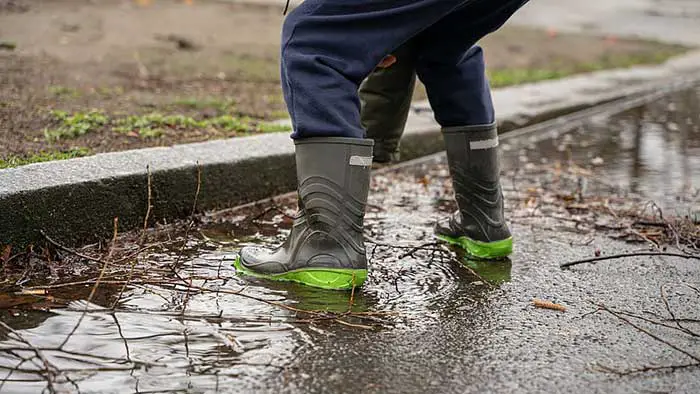Rain boots go a long way towards guaranteeing foot safety. Wearing the correct rain boot can keep you from strolling around in your shoes that feel like a swimming pool. It protects your feet and the lower half of your legs from being drenched in rain, mud, and snow, among other things.

Rain boots do stretch with time as they are worn. After a few weeks of use, the rubber will soften and stretch to better suit your foot. The material they’re normally made of isn’t usually flexible or breathable, and they’re usually quite roomy, even when ordered in the correct size.
But if you have got the wrong-sized boots, don’t worry, you can easily stretch them out yourself.
Here in this article, we have tried to cover as much details about rain boots so that it fits well to your convenience.
Are rain boots ideal only during the rainy season?
Rain boots are designed to withstand mud, rain, seawater, sand and gravel, and anything else you can think of. The traditional rain boot is fully waterproof and protects your pants and legs.
This means that when you take them off, the mud stays on the boot rather than your jeans and socks. It doesn’t have to be raining for you to wear your rain boots as you can definitely wear them any time there are puddles present.
Especially if you live in Seattle, Washington, you never know what to wear. The prediction may suggest sunlight with a chance of rain, with a low of 36 degrees and a high of 75 degrees, but you could end up with an unexpected snowstorm. (Do Rain Boots Work in The Snow?)
Leather is not your ally on a rainy day, believe me. As a result, rain boots are the “go-to” footwear for uncertain weather.
It’s a personal preference whether your boots are tight or loose, but both have advantages. When you walk, a tighter boot provides more stability and won’t slide over your feet or ankles.
This reduces the risk of injury from a fall or a misstep on uneven ground. A risk of a too-loose boot is that it can fall off your foot and you will lose it completely. This might happen when there is a lot of mud or snow on the ground.
After only a few minutes of wear, a too-tight boot can cause blisters and other foot problems. This can be lessened by wearing appropriate socks, although tighter-fitting boots can still cause blisters if worn for an extended period of time. Boots that are too tight limit blood flow too.
Therefore, rain boots should not be overly tight. A tight rain boot will obstruct your foot’s circulation which isn’t good for your health. Rain boots should be slightly loose, but not excessively so.
So it is well known by now that your rain boots should be spacious and roomy, but what if you have the wrong-sized rain boots?
Shoes that were ordered in the wrong size by mistake may not fit your feet and may cause damage if you attempt to shove them on. A pair of shoes that is the wrong size might cause:
-
-
- Injure your feet while jogging or walking
- cause foot abnormalities such as mallet toe or bunion
- cause finger damage such as bone constriction, numbness, and irritation
-
Therefore, here, we’ve provided you ways of stretching them out on your own so that you avoid these problems:
4 Easy Ways to Stretch Rain Boots
1. Try stretching the shoes with ice
This method is appropriate for small to medium alterations. With only a few ordinary household items, such as water, two plastic Ziploc bags, and a freezer, you can stretch your rain boots at home.
The following are the steps:
1.) Fill about 1/3rd part in two Ziploc bags with water. Place the water bags in each of the shoes in such a way as the water is in contact with the inner layer of the boots.
2.) After that, put your rubber boots in the freezer and let them remain overnight.
3.) The next day, take your shoes out of the freezer and let the ice melt. Try on your shoes, and repeat the process to make your modifications.
Rubber-safe stretching liquids can be used to stretch out your rain boots quickly. When they are utilised, a chemical reaction occurs with the rubber, causing it to become flexible and stretch out.
Combine the liquid with a 50/50 water/alcohol solution. Apply a small amount to the area you wish to stretch to ensure it is safe for your shoes. Put the boots on for an hour with thick socks and then add extra socks for more stretching.
2. Use a hairdryer for heat expansion
Yes, you read that right. You can extend your shoes as much as you desire with the help of this method. All you’ll need are a pair of thick socks and a blow dryer set to high heat.
→ Before you wear out your shoes, put on a pair of thick socks.
→ Set the hairdryer to high heat and place it 5cm-10cm away from the shoes.
→ Make sure you walk around with them for an additional 30 minutes once the heating session is finished.
→ The procedure is repeated until the desired stretching is achieved.
3. You can get a rain boot stretcher
They are compatible with all types of boots. There’s no reason to be concerned about chemicals or specific models.
It starts out as a stick with a stretcher attached to the end. It can be inserted into any region of the boot’s leg and then stretched.
Usually you have to leave it anywhere between 24-48 hours. You can stretch your ankles, calves, and even your toes this way!
However, excessive usage of a stretcher can cause your boot to rip apart, so be careful.
4. Get it stretched by a professional
You can hire an experienced cobbler to complete the work if you don’t have enough time or confidence in yourself. Cobblers have the right equipment, resources, and experience to stretch shoes.
Furthermore, they can determine whether your boots are stretchable or not. They can stretch your rubber boots to make them fit perfectly or recommend a new pair.
Are rain boots the same size as your regular shoes?
Rain boots are normally a half-size larger than regular shoes. Consider the type of socks you’ll be wearing inside your boots before going down a size.
Thick socks can help compensate for the looser fit. To receive an exact size recommendation, refer to the brand’s sizing guide and measure the length of your foot.
How long does it take for rain boots to break in?
Usually, it takes about 3-4 weeks to break in. Breaking in your favourite pair of boots can be done in a variety of ways. However, do not rush towards them. Allow some time for your new shoes to break in and stretch out naturally.
How many times can you stretch your rain boots?
It is entirely up to you to determine how many times you can stretch them.
Rubber boots, unfortunately, lose their integrity and sole strength as they stretch. You should not experience any degradation if your stretching is kept in check.
Should you stretch your new rain boots?
You can stretch your new rain boots, but it is best if you do not do it right away. Break-in will take place in your new rubber boots over time. It will become soft, tight, and stretched out eventually.
Wear your shoes around your feet and let them stretch on their own. Even so, if they stay on the tighter and harder side, you should stretch them out using one of the methods mentioned above.
See also: 10 Ways To Stretch Steel Toe Work Boots FAST
Conclusion
Rubber boots are incredible and can be kept in decent condition with minimal care.
Wearing the right pair of rain shoes not only keeps your feet dry and safe, but it also feels comfortable even if the weather is not in your favour.







